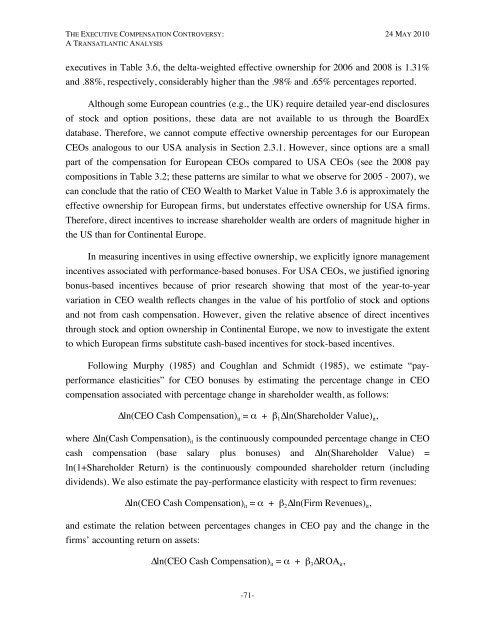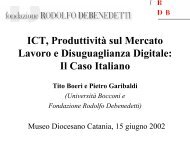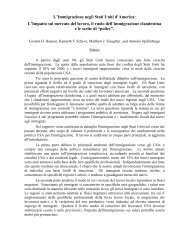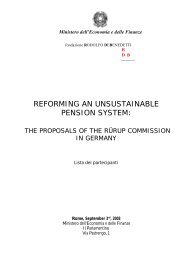The Executive Compensation Controversy - Fondazione Rodolfo ...
The Executive Compensation Controversy - Fondazione Rodolfo ...
The Executive Compensation Controversy - Fondazione Rodolfo ...
You also want an ePaper? Increase the reach of your titles
YUMPU automatically turns print PDFs into web optimized ePapers that Google loves.
THE EXECUTIVE COMPENSATION CONTROVERSY: 24 MAY 2010A TRANSATLANTIC ANALYSISexecutives in Table 3.6, the delta-weighted effective ownership for 2006 and 2008 is 1.31%and .88%, respectively, considerably higher than the .98% and .65% percentages reported.Although some European countries (e.g., the UK) require detailed year-end disclosuresof stock and option positions, these data are not available to us through the BoardExdatabase. <strong>The</strong>refore, we cannot compute effective ownership percentages for our EuropeanCEOs analogous to our USA analysis in Section 2.3.1. However, since options are a smallpart of the compensation for European CEOs compared to USA CEOs (see the 2008 paycompositions in Table 3.2; these patterns are similar to what we observe for 2005 - 2007), wecan conclude that the ratio of CEO Wealth to Market Value in Table 3.6 is approximately theeffective ownership for European firms, but understates effective ownership for USA firms.<strong>The</strong>refore, direct incentives to increase shareholder wealth are orders of magnitude higher inthe US than for Continental Europe.In measuring incentives in using effective ownership, we explicitly ignore managementincentives associated with performance-based bonuses. For USA CEOs, we justified ignoringbonus-based incentives because of prior research showing that most of the year-to-yearvariation in CEO wealth reflects changes in the value of his portfolio of stock and optionsand not from cash compensation. However, given the relative absence of direct incentivesthrough stock and option ownership in Continental Europe, we now to investigate the extentto which European firms substitute cash-based incentives for stock-based incentives.Following Murphy (1985) and Coughlan and Schmidt (1985), we estimate “payperformanceelasticities” for CEO bonuses by estimating the percentage change in CEOcompensation associated with percentage change in shareholder wealth, as follows:∆ln(CEO Cash <strong>Compensation</strong>) it = α + β 1 ∆ln(Shareholder Value) it ,where ∆ln(Cash <strong>Compensation</strong>) it is the continuously compounded percentage change in CEOcash compensation (base salary plus bonuses) and ∆ln(Shareholder Value) =ln(1+Shareholder Return) is the continuously compounded shareholder return (includingdividends). We also estimate the pay-performance elasticity with respect to firm revenues:∆ln(CEO Cash <strong>Compensation</strong>) it = α + β 2 ∆ln(Firm Revenues) it ,and estimate the relation between percentages changes in CEO pay and the change in thefirms’ accounting return on assets:∆ln(CEO Cash <strong>Compensation</strong>) it = α + β 3 ∆ROA it ,-71-









